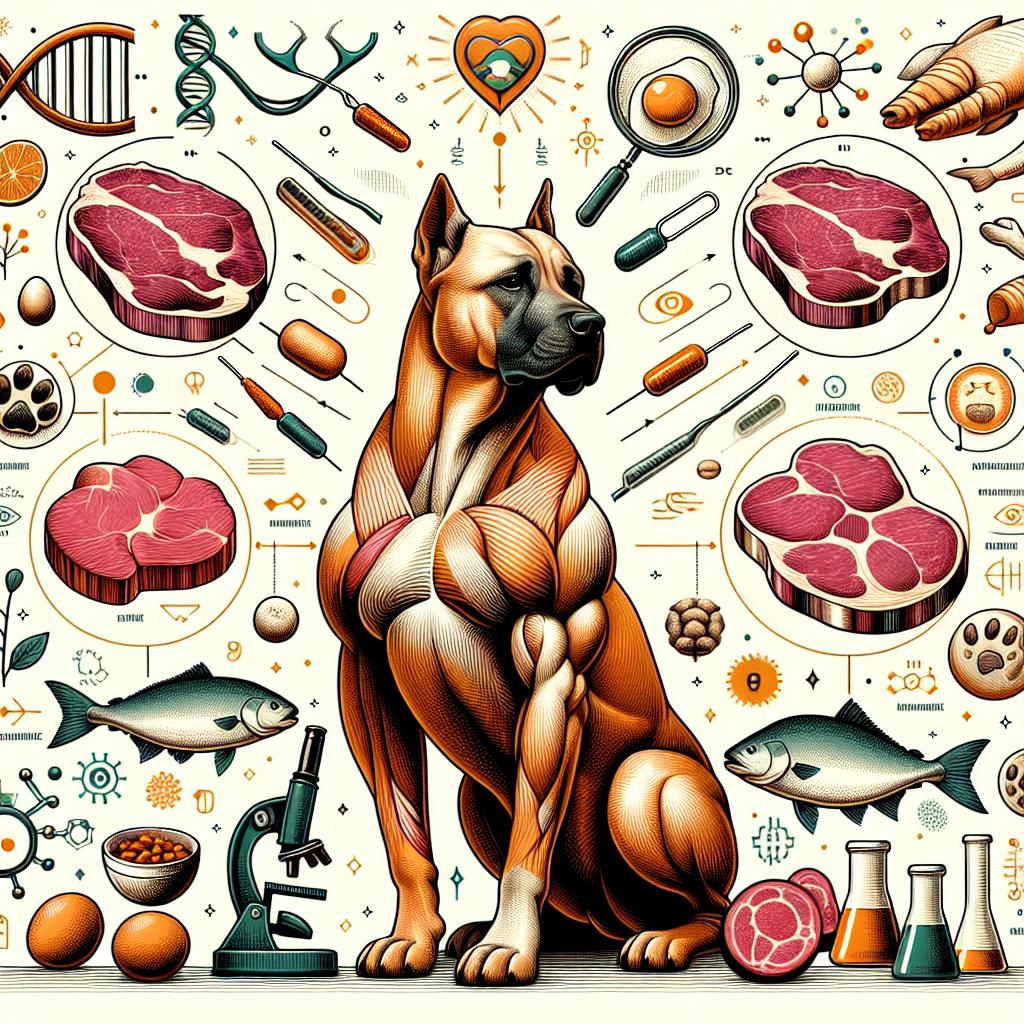In the pursuit of optimal canine health, pet owners are constantly seeking the best dietary solutions to keep their furry companions vibrant and energetic. Among these solutions, a high-protein diet has emerged as a prominent contender, promising a range of benefits that cater to the unique needs of dogs. But what makes protein such a fundamental building block in a dog’s nutrition? From supporting muscle development and energy levels to enhancing overall well-being, the advantages of incorporating protein-rich foods into your dog’s diet are manifold. As we delve into the specifics of why a high-protein diet might be the key to unlocking your dog’s full potential, we’ll explore the science behind canine nutrition, the various protein sources available, and practical tips for transitioning your pet to a protein-packed menu. Join us on this journey to understand why a high-protein diet could be a game changer for your four-legged friend.
Understanding Proteins Role in Canine Health
Proteins are the building blocks of life, playing a crucial role in the overall health and wellness of dogs. A high-protein diet can support various bodily functions, from muscle development to immune system regulation. Essential amino acids found in protein are vital for maintaining healthy skin and coats, repairing tissues, and producing enzymes and hormones that ensure proper bodily functions. Additionally, a protein-rich diet can help sustain energy levels, making it particularly beneficial for active breeds and working dogs.
When considering a high-protein diet, it’s important to choose quality sources of protein. Ingredients such as lean meats, fish, and eggs provide high biological value, meaning they offer amino acids in ratios that are ideal for canine metabolism. Below are some examples of protein sources suitable for dogs:
| Protein Source | Amino Acid Type | Benefits |
|---|---|---|
| Chicken | Complete | Supports muscle growth |
| Fish | Complete | Enhances coat health |
| Eggs | Complete | Boosts immunity |
| Beef | Complete | Provides energy |
By prioritizing high-quality protein sources, dog owners can ensure that their pets receive the necessary nutrients for optimal health. Moreover, a protein-rich diet can help manage weight by promoting lean muscle mass, which minimizes fat accumulation. With the right balance of protein, dogs can lead healthier, more vibrant lives, ultimately thriving both physically and mentally.

Choosing the Right Protein Sources for Your Dog
When it comes to selecting protein sources for your dog, it’s essential to focus on quality and variety. Dogs thrive on a diet that combines different types of proteins, which can offer not only essential amino acids but also additional nutrients that promote overall health. Look for animal-based proteins as they are typically more digestible and beneficial. Some top choices include:
- Chicken – Lean and rich in protein for muscle maintenance.
- Fish – Contains omega fatty acids, great for skin and coat health.
- Lamb – A unique protein source, ideal for dogs with food sensitivities.
- Beef – Packed with iron and other essential minerals.
Incorporating plant-based proteins can also be beneficial, particularly for dogs with specific dietary needs. While they shouldn’t be the primary protein source, options like quinoa and peas can enhance nutritional diversity. When choosing protein sources, consider consulting with your veterinarian to ensure that your dog’s diet meets all necessary dietary requirements. Below is a simple comparison table of protein sources for easy reference:
| Protein Source | Key Nutrients | Best For |
|---|---|---|
| Chicken | Lean protein, B vitamins | Active dogs |
| Fish | Omega-3 fatty acids | Skin conditions |
| Lamb | Zinc, iron | Allergy-prone dogs |
| Beef | High in iron | Muscle building |
| Quinoa | Complete protein, fiber | Supplemental options |

Tailoring a High-Protein Diet to Meet Your Dogs Needs
When considering a high-protein diet for your dog, it’s essential to recognize that not all dogs have the same nutritional requirements. Factors such as age, size, breed, and activity level can significantly influence your dog’s protein needs. For instance, puppies and
- Lean meats such as chicken, turkey, and beef
- Fish like salmon or sardines for omega-3 fatty acids
- Eggs which provide excellent bioavailable protein
- Dairy products such as yogurt (if lactose tolerant)
- Plant-based proteins like quinoa and lentils
Additionally, understanding how to proportion protein within your dog’s diet is crucial. A helpful guide is based on the calorie needs of your dog, as seen in the table below. This ensures they receive the appropriate amount of protein while maintaining a balanced diet. Remember that gradual changes are best when introducing a new diet, giving your dog’s digestive system time to adjust.
| Dog Size | Daily Caloric Needs | Protein (grams) |
|---|---|---|
| Small (up to 20 lbs) | 400-600 | 30-50 |
| Medium (20-50 lbs) | 600-1,300 | 50-100 |
| Large (50-100 lbs) | 1,300-2,000 | 100-200 |
Monitoring and Adjusting Your Dogs Protein Intake
As you embark on the journey of enhancing your dog’s diet with a high-protein regimen, it’s essential to monitor their protein intake closely. Each dog is unique, and their individual needs can fluctuate based on factors such as age, weight, activity level, and overall health. Consider observing your dog’s energy levels, coat quality, and physical condition; these are indicators of how well they’re responding to the increased protein. Keeping a log of your dog’s weight and behavior can help you determine whether adjustments are necessary. A few signs that might indicate your dog needs a change include:
- Excessive Weight Gain: If your dog is gaining weight too rapidly, it may be time to reassess their protein sources and quantity.
- Low Energy: A sudden drop in energy levels might suggest that the current protein amount isn’t meeting their needs.
- Digestive Issues: Any signs of stomach upset, such as diarrhea or vomiting, could indicate that the protein source is not suitable.
Adjusting your dog’s protein intake may involve switching to different protein sources or modifying the portion sizes. It’s advisable to consult with a veterinarian before making significant changes, as they can provide personalized recommendations based on your dog’s health profile. When transitioning to a higher protein diet, do so gradually over a week or more to prevent digestive upset. Use the table below to guide your adjustments based on your dog’s weight and ideal protein intake.
| Dog Weight (lbs) | Recommended Protein Intake (grams/day) |
|---|---|
| 10 | 25-30 |
| 20 | 40-50 |
| 40 | 80-100 |
| 60 | 100-130 |
Q&A
Q&A: The Benefits of a High-Protein Diet for Dogs
Q1: What exactly is a high-protein diet for dogs?
A: A high-protein diet for dogs typically consists of food that contains a higher percentage of protein than standard dog food. This diet often includes premium sources of protein such as meat, fish, eggs, and certain plant-based ingredients. It fulfills the nutritional needs of dogs, especially those who are very active or have specific health requirements.
Q2: Why is protein important for dogs?
A: Protein plays a crucial role in a dog’s overall health. It supports muscle development, aids in tissue repair, boosts the immune system, and contributes to the production of enzymes and hormones. Essentially, protein is vital for every cell in a dog’s body, making it fundamental for their growth, energy, and vitality.
Q3: What are the benefits of a high-protein diet?
A: There are several benefits to adopting a high-protein diet for dogs, including:
- Muscle Maintenance: Particularly beneficial for active or aging dogs, protein helps maintain lean muscle mass.
- Increased Energy Levels: A protein-rich diet can provide sustained energy, making it ideal for working or athletic dogs.
- Better Weight Management: Protein-rich diets can increase satiety, helping dogs feel full and potentially aiding in weight loss or maintenance.
- Improved Coat and Skin Health: Quality protein helps maintain a healthy coat and skin, reducing issues like dryness or flakiness.
- Enhanced Immune Function: Proteins play a role in creating antibodies, contributing to a stronger immune system.
Q4: Are there specific types of proteins that are better for dogs?
A: Yes! Animal-based proteins such as chicken, beef, lamb, and fish are excellent sources due to their amino acid profiles. Omega-rich fish, like salmon, also provide essential fatty acids that improve skin and coat health. Plant-based proteins, like lentils and chickpeas, can supplement diets but should be balanced with animal proteins to offer complete nutrition.
Q5: Could there be any downsides to a high-protein diet?
A: While high-protein diets can be beneficial, they’re not suitable for all dogs. Dogs with certain health conditions, like kidney disease, may require a lower protein intake. It’s essential to consult with a veterinarian before making significant changes to your dog’s diet to ensure it meets their specific health needs.
Q6: How should I transition my dog to a high-protein diet?
A: To switch to a high-protein diet, gradually introduce the new food over a week or so. Start by mixing it with your dog’s current food, slowly increasing the ratio of the new food. Monitor your dog for any gastrointestinal upset during the transition but remember, every dog is unique.
Q7: Can a high-protein diet benefit all dog breeds?
A: While many dogs can benefit from a high-protein diet, individual needs vary by breed, age, size, and activity level. Active breeds or those working in fields may need more protein compared to sedentary breeds. Always tailor your dog’s diet to their specific lifestyle and health requirements.
Q8: What alternatives exist for dogs who are sensitive to specific proteins?
A: For dogs with protein sensitivities, there are alternatives available, such as novel protein sources (like duck or venison) or hypoallergenic diets. Consult with a veterinarian to find suitable protein options that won’t trigger allergic reactions while still providing the necessary nutrients.
Q9: How can I tell if my dog’s high-protein diet is working?
A: Signs that your dog’s high-protein diet is benefiting them include increased energy, good coat condition, healthy weight maintenance, and overall vitality. Regular vet check-ups can further assess the health impacts of their diet and ensure optimal nutrition.
Q10: Any final thoughts on high-protein diets for dogs?
A: High-protein diets can be a great option for many dogs when balanced correctly. Monitoring your pet’s health and consulting with a veterinarian will ensure that your furry friend thrives on a diet that meets their specific needs. Happy feeding!
The Way Forward
embracing a high-protein diet for your canine companion can bring forth a host of benefits, ranging from improved energy levels to enhanced muscle development and overall vitality. As our furry friends continue to thrive by our side, it is essential to align their nutritional needs with the active lifestyles they lead. By carefully selecting high-quality protein sources and consulting with a veterinarian to tailor the diet to your dog’s specific requirements, you can pave the way for optimal health and happiness.
As we move forward in our understanding of canine nutrition, let us remember that what we feed our dogs is not just sustenance, but a powerful tool to enrich their lives. So, whether your dog is a playful puppy or a wise old soul, consider the possibilities that a high-protein diet can offer, ensuring a long, spirited journey together.

